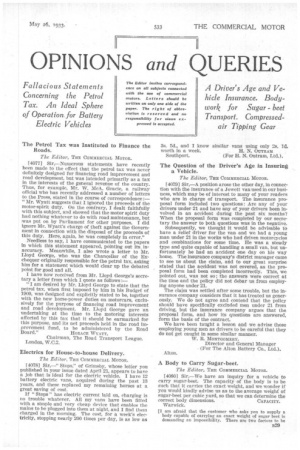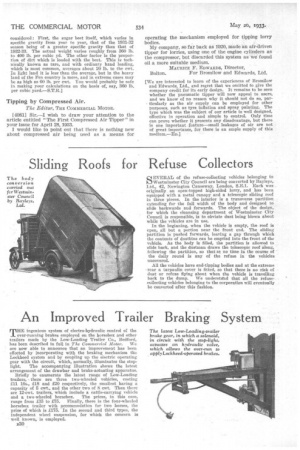OPINIONS and QUERIES
Page 43

Page 44

If you've noticed an error in this article please click here to report it so we can fix it.
Fallacious Statements Concerning the Petrol Tax. An Ideal Sphere of Operation, for Battery Electric Vehicles A Driver's Age and Vehicle Insurance. Body. work for Sugar beet Transport. Compressed air Tipping Gear
The Petrol Tax was Instituted to Finance the Roads.
The Editor, THE COMMERCIAL MOTOR.
[40771 Sir,—Numerous statements have recently been made to the effect that the petrol tax was never definitely designed for financing road improvement and road development, but was intended primarily as a tax in the interests of the general revenue of the country. Thus, for example, Mr. W. lIcA. Gracie, a railway official who has recently addressed a number of letters to the Press, stated in the course of correspondence :— "Mr. Wyatt suggests that I ignored the proceeds of the motor-spirit duty. On the contrary, I dealt faithfully with this subject, and showed that the motor spirit duty had nothing whatever to do with road maintenance, but was put on by Parliament for other purposes. I did ignore Mr. Wyatt's charge of theft against the Government in connection with the disposal of the proceeds of this duty. Here, again, he was completely in error."
Needless to say, I. have communicated to the papers In which this statement appeared, pointing out its. inaccuracy. Meanwhile, I also wrote a letter to Mr. Lloyd George, who was the Chancellor of the Exchequer originally responsible for the petrol tax, asking him for a statement which would clear up the debated point for good and all.
I have now received from Mr. Lloyd George's secretary a letter from which I quote as follows:— " I am desired by Mr. Lloyd George to state that the petrol tax, when first imposed by him in his Budget of 1909, was designed and explicitly stated to be, together with the new horse-power duties on motorcars, exclusively for the purpose of financing road improvement and road development. Mr. Lloyd George gave an undertaking at the time to the motoring interests affected by this tax that it should be earmarked for this purpose, and its net proceeds held in the road improvement fund, to be administered by the Road Board." HORACE WYATT, Chairman, The Road Transport League. London, W.C.2.
Electrics for House-to-house Delivery.
The Editor, THE COMMERCIAL MOTOR.
14078] Sir,—" Stops." of Grimsby, whose letter you published in your issue dated April 21, appears to have a job that is ideal for the electric vehicle. I have 12 battery electric vans, acquired during the past 13 years, and these replaced my remaining horses at a great saving of cost.
If " Stops " has electric current laid on, charging is no trouble whatever. All my vans have been fitted with a simple and very cheap device that enables the mains to be plugged into them at night, and I find them charged in the morning. The cost, for a week's electricity, stopping nearly 200 times per day, is as low as 3s. 5d., and I know similar vans using only 2s. id.
worth in a week. H. N. OUTRAM Southport. (For H. N. Outram, Ltd.).
The Question of the Driver's Age in Insuring a Vehicle.
The Editor, TEE COMMERCIAL MOTOR.
14079] Sir,—A position arose the other day, in connection with the insurance of a Jowett van used in our business, which may be of interest to many of your readers who are in charge of transport. The insurance proposal form included two questions: Are any of your drivers under 21 and have any of your drivers been involved in an accident during the past six months? When the proposal form was completed by our secretary the answer to both questions was in the negative.
Subsequently, we thought it would be advisable to have a relief driver for the van and we had a young man under 21 in the works who had driven motorcycles and combinations for some time. He was a steady type and quite capable of handling a small van, but unfortunately he had an accident one day on his way home. The insurance company's district manager came to see us about the claim, and to our great surprise stated that the accident was not covered, as the proposal form had been completed incorrectly. This, we pointed out, was not so; the answers were correct at the time and the policy did not debar us from employing anyone under 21.
The claim was settled after some trouble, but the Insurance company considers that it has treated us generously. We do not agree and contend that the policy should have specifically excluded men under 21 from driving, but the insurance company argues that the proposal form, and how its questions are answered, form the basis of the contract.
We have been taught a lesson and we advise those employing young men as drivers to be careful that they do not get caught in some similar manner.
W. R. MONTGOMERY, Director and General Manager
(For The Alton Battery Co., Ltd.). Alton.
A Body to Carry Sugar-beet.
The Editor, THE COMMERCIAL MOTOR.
[4080] Sir,—We have an inquiry for a vehicle to carry sugar-beet. The capacity of the body is to be such that it carries the exact weight, and we wonder if you would kindly advise us as to the average weight of sugar-beet per cubic yard, so that we can determine the
correct body dimensions. CAPACITY. Warwick.
[I am afraid that the customer who asks you to supply a body capable of carrying an exact weight of sugar beet is demanding an impossibility. There are two factors to be e29 considered : First, the sugar beet itself, which varies in specific gravity from year to year, that of the 1931-32 season being of a greater specific gravity than that of 1932-33. The actual weight varies roughly from 360 lb. to 400 lb. per cubic yd. The other factor, is the proportion of dirt which is loaded with the beet. This is technically known as tare, and with ordinary hand loading, which is most common, averages about 20 lb. to the cwt. In light land it is less than the average, but in the heavy land of the Fen country is more, and in extreme cases may be as high as 60 lb. per cwt. You would probably be safe in making your calculations on the basis of, say, 360 lb. per cubic yard.—S.T.R.] Tipping by Compressed Air.
The Editor, THE COMMERCIAL MOTOR.
[4081] Sir,—I wish to draw your attention to the article entitled "The First Compressed Air Tipper" in your issue for April 28, 1933.
I would like to point out that there is nothing new about compressed air being used as a means for operating the mechanism employed for tipping lorry bodies.
My company, so far back as 1920, made an air-driven tipper for lorries, using one of the engine cylinders as the compressor, but discarded this system as we found oil a more suitable medium.
MAURICE E. EDWARDS, Director, Bolton. For Bromilow and Edwards, Ltd.
[We are interested to learn of the experiences of Bromilow and Edwards, Ltd., and regret that we omitted to give the company credit for its early design. It remains to be seen whether the pneumatic tipper will now appeal to users, and we know of no reason why it should not do so, particularly as the air supply can be employed for other purposes, such as tyre inflation and spray painting. The type which was the subject of our article is well designed, effective in operation and simple to control. Only time can prove whether it presents any disadvantage, but there is one important feature—small leakages of air are not of great importance, for there is an ample supply of this medium.—En.]




























































































